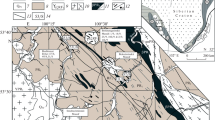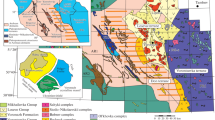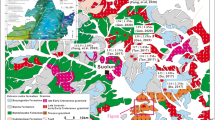Abstract
The results of geochronological and petrological studies of the largest mafic dyke in the northern part of the Fennoscandian Shield, called the Great Dyke of the Kola Peninsula (GDK), are presented. According to U-Pb D-TIMS baddeleyite dating, the GDK crystallization age is 2680 ± 6 Ma. The age of host granites is 2.75–2.72 Ga (U-Pb, zircon, SHRIMP-II). The dyke has a simple internal structure with no signs of multistage melt injection. It comprises equigranular and plagioclase-porphyritic dolerites and gabbro that are amphibolitized to varying degrees. All rocks are low-Mg (Mg# less than 0.37) with low concentrations of Cr and Ni, and were derived through differentiation of more primitive melts. The analysis of geochemical and Sr-Nd isotopic data suggests that GDK melts could be formed by mixing of two types of mantle melts: depleted asthenospheric melt and enriched melt formed via melting of a lithospheric mantle. The weakly fractionated HREE patterns indicate that primary GDK melts originated at shallow (<60 km) depths outside the garnet stability field. The generation and injection of melts of the Neoarchean GDK occurred immediately after large-scale granitic magmatism and main crustal growth event in the Murmansk Craton and marked the cratonization of the continental lithosphere in the northeastern part of the Fennoscandian Shield.











Similar content being viewed by others
Notes
Supplementary to Russian and English on-line versions of paper are given at sites https://elibrary.ru/ and http://springer.longhoe.net/ соответственно приведены: Supplementary 1: ESM_1.xlsx—Results of measurement of standard samples; Supplementary 2: ESM_2.xlsx—Compositions of minerals in GDK dolerites; Supplementary 3: ESM_3.xlsx—U-Pb data on sample Ca-812-16; Supplementary 4: ESM_4.xlsx—U-Pb data on sample Ca-554-3; Supplementary 5: ESM_5.xlsx—Composition of host rocks.
REFERENCES
Arzamastsev, A.A., Fedotov, Zh.A., and Arzamastseva, L.V., Daikovyi magmatizm severo-vostochnoi chasti Baltiiskogo shchita (Dike Magmatism of the Northeastern Baltic Shield), Moscow: Nauka, 2009.
Austin, J.M., Hayman, P.C., Murphy, D.T., et al., The voluminous 2.81–2.71 Ga Goldfields tholeiitic super event: implications for basin architecture in the Yilgarn craton and global correlations, Precambrian Res., 2022, vol. 369, 106528.
Balagansky, V.V., Bibikova, E.V., Bogdanova, S.V., et al., U-Pb geochronology of Belomorides of the Tupaya uba area, Lake Kovdozero, Northern Karelia, Izv. AN SSSR, Ser. Geol., 1990, no. 6, pp. 40–51.
Balagansky, V.V., Glaznev, V.N., and Osipenko, L.G., The Early Proterozoic evolution of the northeastern Baltic Shield: a terrane analysis, Geotectonics, 1998, vol. 32, no. 2, pp. 81–92.
Balagansky, V.V., Mints, M.V., Daly, D.S., Paleoproterozoic Lapland–Kola orogen, Stroenie i dinamika litosfery Vostochnoi Evropy. Rezul’taty issledovanii po programme EUROPROBE (Structure and Dynamics of the Lithosphere of East Europe. Results of Studies in the Framework of EUROPROBE Program), Moscow: Geokart, 2006, pp. 158–171.
Le Bas, M.J., Le Matre, R.W., Streckeisen, A., Zanettin, B.A., Chemical classification of volcanic rocks based on the total alkali–silica diagram, J. Petrol., 1986, vol. 27, pp. 745–750.
Black, L.P., Kamo, S.L., Allen, C.M., et al., Temora 1: a new zircon standard for Phanerozoic U-Pb geochronology, Chem. Geol., 2003, vol. 200, nos. 1–2, pp. 155–170.
Bleeker, W. and Ernst, R.R.E., Short-lived mantle generated magmatic events and their dyke swarms: the key unlocking earth’s paleogeographic record back to 2.6 Ga, Dyke Swarms—Time Markers of Crustal Evolution. Proceed. Fifth Int. Dyke Conference, 2006, pp. 3–26.
Bogdanova, S.V., Gorbatschev, R., and Garetsky, R.G., Europe|East European Craton, Reference Module in Earth Systems and Environmental Sciences, 2016. https://doi.org/10.1016/B978-0-12-409548-9.10020-X
Bonin, B., Do coeval mafic and felsic magmas in post-collisional to within-plate regimes necessarily imply two contrasting, mantle and crustal, sources? A review, Lithos, 2004, vol. 78, no. 1, pp. 1–24.
Corfu, F., Hanchar, J.M., Hoskin, P.W.O., et al., Atlas of zircon textures, Rev. Mineral. Geochem., 2003, vol. 53, pp. 469–499.
Cottin, J.Y., Lorand, J.P., Agrinier, P., et al., Isotopic (O, Sr, Nd) and trace element geochemistry of the Laouni layered intrusions (Pan-African Belt, Hoggar, Algeria): evidence for post-collisional continental tholeiitic magmas variably contaminated by continental crust, Lithos, 1998, vol. 45, nos. 1–4, pp. 197–222.
Daly, J.S., Balagansky, V.V., Timmerman, M.J., and Whitehouse, M.J., The Lapland–Kola orogen: Palaeoproterozoic collision and accretion of the northern Fennoscandian lithosphere, Geol. Soc. London: Mem., 2006, vol. 32, pp. 579–598. https://doi.org/10.1144/GSL.MEM.2006.032.01.35
Daly, J.S., Balagansky, V.V., Timmerman, M.J., et al., Ion microprobe U-Pb zircon geochronology and isotopic evidence for a trans-crustal suture in the Lapland–Kola orogen, northern Fennoscandian Shield, Precambrian Res., 2021, vol. 105, pp. 289–314. https://doi.org/10.1016/S03019268(00)00116-9
Ernst, R.E., Large Igneous Provinces, Cambridge: University Press, 2014.
Ernst, R.E. and Bell, K., Petrology of the great Abitibi dyke, Superior, J. Petrol., 1992, vol. 33, no. 2, pp. 423–469.
Ernst, R.E., Liikane, D.A., Jowitt, S.M., et al., A new plumbing system framework for mantle plume-related continental large igneous provinces and their mafic-ultramafic intrusions, J. Volcanol. Geotherm. Res, 2019, vol. 384, pp. 75–84.
Ernst, R.E., Bond, D.P.G., Zhang, S., et al., Large igneous province record through time and implications for secular environmental changes and geological time-scale boundaries, Large Igneous Provinces: A Driver of Global Environmental and Biotic Changes, Wiley, 2021, pp. 1–26.
Fedotov Zh.A., Bayanova T.B., Serov P.A. Spatiotemporal relationships of dike magmatism in the Kola Region, the Fennoscandian Shield, Geotectonics, 2012, vol. 46, no. 6, pp. 412–426.
Geologiya SSSR. Murmanskaya oblast' (Geology of the USSR. Murmansk Region), Moscow: Gosgeoltekhizdat, 1958.
Goldstein, S.J. and Jacobsen, S.B., The Nd and Sr isotopic systematics of river-water dissolved material: implications for the sources of Nd and Sr in seawater, Chem. Geol. Isot. Geosci. Sect., 1987, vol. 66, no. 3, pp. 245–272.
Halls, H.C., Hamilton, M.A., and Denyszyn, S.W., The Melville Bugt dyke swarm of Greenland: a connection to the 1.5–1.6 Ga Fennoscandian rapakivi granite province? Dyke Swarms: Keys for Geodynamic Interpretation: Keys for Geodynamic Interpretation, Srivastava, R.K., Ed., Berlin–Heidelberg: Springer Berlin Heidelberg, 2011.
Hayman, P.C., Thebaud, N., Pawley, M.J., et al., Evolution of a ~2.7 Ga large igneous province: a volcanological, geochemical and geochronological study of the Agnew greenstone belt, and new regional correlations for the Kalgoorlie terrane (Yilgarn craton, western Australia), Precambrian Res., 2015, vol. 270, pp. 334–368.
Hoek, J.D., Mafic Dykes of the Vestfold Hills, East Antarctica. An Analysis of the Emplacement Mechanism of Tholeiitic Dyke Swarms and of the Role of Dyke Emplacement during Crustal Extension, PhD thesis, Utrecht University, 1994.
Hölttä, P., Balagansky, V., and Garde, A., Archean of Greenland and Fennoscandia, Episodes, 2008, vol. 31, no. 1, pp. 13–19.
Irvine, T.N. and Baragar, W.R.A., A guide to the chemical classification of the common volcanic rocks, Can. J. Earth Sci., 1971, vol. 8, pp. 523–548.
Johansson, Å., Bingen, B., Huhma, H., et al., A geochronological review of magmatism along the external margin of Columbia and in the Grenville-age orogens forming the core of Rodinia, Precambrian Res., 2022, vol. 371, 106463.
Kalsbeek, F. and Taylor, P.N., Chemical and isotopic homogeneity of a 400 km long basic dyke in central West Greenland, Contrib. Mineral. Petrol., 1986, vol. 93, no. 4, pp. 439–448.
Kingsbury, C.G., Klausen, M.B., Soderlund, U., et al., Identification of a new 485 Ma post-orogenic mafic dyke swarm east of the Pan-African Saldania–Gariep belt of South Africa, Precambrian Res., 2021, vol. 354, p. 106043.
Klausen, M.B., Conditioned duality between supercontinental ‘assembly’ and ‘breakup’ lips, Geosci. Front., 2020, vol. 11, no. 5, pp. 1635–1649.
Klein, E.M., Geochemistry of the igneous oceanic crust, Treatise Geochem., 2003, vol. 3, pp. 433–463.
Kozlov, N.E., Sorokhtin, N.O., Glaznev, V.N., et al., Geologiya arkheya Baltiiskogo shchita (Archean Geology of the Baltic Shield), St. Petersburg: Nauka, 2006.
Krogh, T.E., A low-contamination method for hydrothermal decomposition of zircon and extraction of U and Pb for isotopic age determinations, Geochim. Cosmochim. Acta, 1973, vol. 87, pp. 485–494.
Krogh, T., Corfu, F., Davis, D., Dunning, G.R., et al., Precise U-Pb isotopic ages of diabase dykes and mafic to ultramafic rocks using trace amounts of baddeleyite and zircon, Mafic Dyke Swarms, Geol. Ass. Canada. Spec. Publ, 1987, vol. 34, pp. 147–152.
Larionov, A.N., Andreichev, V.A., and Gee, D.G., The Vendian alkaline igneous suite of northern Timan: ion microprobe U-Pb zircon ages of gabbros and syenite, Geol. Soc. London: Mem., 2004, vol. 30, no. 1, pp. 69–74.
Larionova, Yu.O., Samsonov, A.V., and Shatagin, K.N., Sources of Archean sanukitoids (high-Mg subalkaline granitoids) in the Karelian Craton: Sm-Nd and Rb_Sr isotopic-geochemical evidence, Petrology, 2007, vol. 15, no. 6, pp. 530–550.
Li, T., Zhai, M., Peng, P., et al., Ca. 2.5 billion year old coeval ultramafic–mafic and syenitic dykes in eastern Hebei: implications for cratonization of the North China Craton, Precambrian Res., 2010, vol. 180, nos. 3–4, pp. 143–155.
Ludwig, K.R., PbDat for MS-DOS, version 1.21, U.S. Geol. Survey Open-File Rept., 1991, no. 88-542.
Ludwig, K.R., User’s manual for Isoplot 3.0, A geochronological toolkit for Microsoft Excel, Berkley Geochronol. Center, Spec. Publ., 2003, no. 4.
Ludwig, K.R., SQUID 2 rev. 2.50 a User’s Manual, Berkeley Geochronol. Center Spec. Publ., 2009, vol. 5.
Ludwig, K.R., User’s manual for ISOPLOT/Ex 3.75. A geochronological toolkit for Microsoft Excel, Berkeley Geochronology Center Spec. Publ., 2012, no. 5.
Macdonald, R., Wilson, L., Thorpe, R.S., and Martin, A., Emplacement of the cleveland dyke: evidence from geochemistry, mineralogy, and physical modelling, J. Petrol., 1988, vol. 29, no. 3, pp. 559–583.
McDonough, W.F. and Sun, S.-S., The composition of the earth, Chem. Geol., 1995, vol. 2541, no. 94, pp. 223–253
Morimoto, N., Fabries, J., Ferguson, A.K., et al., Nomenclature of pyroxenes, Am. Mineral., 1988, vol. 77, pp. 1123–1133.
Oberthür, T., Davis, D.W., and Blenkinsop, T.G., Precise U-Pb mineral ages, Rb-Sr and Sm-Nd systematics for the Great Dyke, Zimbabwe - constraints on Late Archean events in the Zimbabwe Craton and Limpopo Belt, Precambrian Res., 2002, vol. 113, pp. 293–305.
Pearce, J.A., Ernst, R.E., Peate, D.W., and Rogers, C., LIP printing: use of immobile element proxies to characterize large igneous provinces in the geologic record, Lithos, 2021, vol. 392–393, 106068.
Pollard, D.D., Elementary fracture mechanics applied to the structural interpretation of dykes, Mafic Dyke Swarms, Geol. Ass. Canada. Spec. Publ., 1987, vol. 34, pp. 5–24.
Pozhilenko, V.I., Serov, P.A., Petrov, V.P., Sm-Nd isotope studies of the Early Precambrian rocks of the Kola region: a brief overview and new data, Vestn. Kol’sk. NTs RAN, 2018, vol. 1 (10), pp. 37–49.
Presnall, D.C., Dixon, S.A., Dixon, J.R., et al., Liquidus phase relations on the join diopside—forsterite–anorthite from 1 atm. to 20 kbar: their bearing on the generation and crystallization of basaltic magma, Contrib. Mineral. Petrol., 1978, vol. 66, pp. Ñ. 203–220.
Rannii dokembrii Baltiiskogo shchita (Early Precambrian of the Baltic Shield), Glebovitskii, V.A, Eds., St. Petersburg: Nauka, 2005. Samsonov, A.V., Stepanova, A.V., Salnikova, E.B., et al., Neoarchean mafic dyke swarms in the murmansk craton: petrology, tectonic setting and paleocontinental significance, Abstract. Int. Conference “Large Igneous Provinces through Earth History: Mantle Plumes, Supercontinents, Climate Change, Metallogeny and Oil–Gas, Planetary Analogues,” Tomsk: CSTI Publishing house, pp. 2–5.
Shumlyanskyy, L., Ernst, R.E., Albekov, A., et al., The early Statherian (ca. 1800–1750 Ma) Prutivka–Novogol large igneous province of Sarmatia: geochronology and implication for the Nuna/Columbia supercontinent reconstruction, Precambrian Res., 2021, vol. 358, p. 106185.
Sklyarov, E.V. and Fedorovskii, V.S., Magma mingling: tectonic and geodynamic implications, Geotectonics, 2006, vol. 40, no. 2, pp. 120–134.
Slabunov, A.I., Stepanova, A.V., Bibikova, E.V., et al., Neoarchean gabbroids of the Fennoscandian Shield Belomorsk Province: geology, composition, and geochronology, Dokl. Earth Sci., 2008, vol. 423, no. 8, pp. 1207–1211.
Söderlund, U. and Johansson, L., A simple way to extract baddeleyite (ZrO2), Geochem. Geophys. Geosys., 2002, vol. 3, no. 2, pp. 1–7.
Song, S.G., Wang, M.J., Wang, C., and Niu, Y.L., Magmatism during continental collision, subduction, exhumation and mountain collapse in collisional orogenic belts and continental net growth: a perspective, Sci. China Earth Sci., 2015, vol. 58, no. 8, pp. 1284–1304.
Stacey, J.S. and Kramers, J.D., Approximation of terrestrial lead isotope evolution by a two-stage model, Earth Planet. Sci. Lett., 1975, vol. 26, no. 2, pp. 207–221.
Stark, J.C., Wilde, S.A., Soderlund, U., et al., First evidence of Archean mafic dykes at 2.62 Ga in the Yilgarn craton, western Australia: links to cratonisation and the Zimbabwe Craton, Precambrian Res., 2018, vol. 317, pp. 1–13.
Steiger, R.H. and Jäger, E., Subcommission on geochronology: convention on the use of decay constants in geo- and cosmochronology, Earth Planet. Sci. Lett., 1977, vol. 36, no. 3, pp. 359–362.
Stepanova, A.V., Samsonov, A.V., Salnikova, E.B., et al., Paleoproterozoic mafic dyke swarms in archean kola-murmansk and karelia provinces, eastern Fennoscandia: barcode comparison and implications for paleocontinental reconstructions, The 33rd Nordic Geol. Winter Meeting. Lyngby, Denmark, 2018. P. 56.
Sun, S.-S. and McDonough, W.F., Chemical and isotopic systematics of oceanic basalts: implications for mantle composition and processes, Geol. Soc. London: Spec. Publ., 1989, vol. 42, pp. 313–345.
Sun, Q., Zhao, X., Xue, C., Seltmann, R., et al., Neoproterozoic tectonic shift from collisional orogenesis to intraplate extension in the Yili block, southern central Asian orogenic belt, Precambrian Res., 2022, vol. 374, p. 106626.
Svetov, S.A., Stepanova, A.V., Chazhengina, S.Yu., et al., Precision (ICP-MS, LA-ICP-MS) analysis of rock and mineral composition: method and assessment of measurement accuracy as exemplified by the Early Precambrian mafic complexes, Tr. Karel’sk. NTs RAN, 2015, no. 7, pp. 173–192.
Tait, J., Straathof, G., Soderlund, U., et al., The Ahmeyim great dyke of Mauritania: a newly dated Archaean intrusion, Lithos, 2013, vol. 174, pp. 323–332.
Thirlwall, M.F., Long-term reproducibility of multicollector Sr and Nd isotope ratio analysis, Chem. Geol., 1991, vol. 94, no. 2, pp. 85–104.
Timmerman, M.J. and Daly, S., Sm-Nd evidence for Late Archaean crust formation in the Lapland–Kola mobile belt, Kola Peninsula, Russia and Norway, Precambrian Res., 1995, vol. 72, pp. 97–107.
Veselovskiy, R.V., Samsonov, A.V., Stepanova, A.V., et al., 1.86 Ga key paleomagnetic pole from the Murmansk craton intrusions - eastern Murman sill province, NE Fennoscandia: multidisciplinary approach and paleotectonic applications, Precambrian Res., 2019, vol. 324, pp. 126–145.
Villa, I.M., De Bièvre, P., Holden, N.E., and Renne, P.R., IUPAC-IUGS recommendation on the half life of 87Rb, Geochim. Cosmochim. Acta, 2015, vol. 164, pp. 382–385.
Vrevskii, A.B., Specifics of the Neoarchean plume–lithospheric processes in the Kola–Norwegian Province of the Fennoscandian Shield: II. Petrology and geodynamic nature of komatiite–tholeiite association, Petrology, 2018, vol. 26, no. 3, pp. 246–254.
Wang, H. and Currie, C.A., Magmatic expressions of continental lithosphere removal, J. Geophys. Res. Solid Earth, 2015, vol. 120, pp. 7239–7260.
Wang, Q., Zhao, J., Zhang, C., et al., Paleozoic post-collisional magmatism and high-temperature granulite-facies metamorphism coupling with lithospheric delamination of the East Kunlun orogenic belt, NW China, Geosci. Front., 2022, vol. 13, no. 1, p. 101271
Warr, L.N., IMA-CNMNC approved mineral symbols, Mineral. Mag., 2021, vol. 85, no. 3, pp. 291–320.
Wiedenbeck, M., Allé, P., Corfu, F., et al., Three natural zircon standards for U-Th-Pb, Lu-Hf, trace element and REE analyses, Geostand. Newsl., 1995, vol. 19, no. 1, pp. 1–23.
Wilcox, R.E., The idea of magma mixing: history of a struggle for acceptance, J. Geol., 1999, vol. 107, pp. 421–432.
Wilson, A.H., The geology of the Great Dyke, Zimbabwe: crystallization, layering, and cumulate formation in the Pl pyroxenite of cyclic unit 1 of the Darwendale subchamber, J. Petrol., 1992, vol. 33, no. 3, pp. 611–663.
Xu, W., Zhao, Z., and Dai, L., Post-collisional mafic magmatism: record of lithospheric mantle evolution in continental orogenic belt, Sci. China Earth Sci., 2020, vol. 63, no. 12, pp. 2029–2041.
ACKNOWLEDGMENTS
Our studies were largely conducted owing to V.S. Kulikov, his encyclopedic knowledge and keen interest in the geology of Fennoscandia. Discussions on mafic dykes of the Fennoscandian Shield with V.S. Kulikov motivated us to study the Great Dyke of the Kola Peninsula, which is an important but forgotten for decades object. Our thanks for help in expedition works are addressed to the crew of the Udacha vessel O.U. Mingazov and G.I. Mukhin. Constructive comments of reviewers A.A. Nosova and N.M. Kudryashov significantly improved our manuscript.
Funding
The studies were supported by the Russian Science Foundation (project no. 16-17-10260P).
Author information
Authors and Affiliations
Corresponding author
Ethics declarations
The authors declare that they have no conflicts of interest.
Additional information
Translated by M. Bogina
Rights and permissions
About this article
Cite this article
Stepanova, A.V., Samsonov, A.V., Salnikova, E.B. et al. The Great Dyke of the Kola Peninsula as a Marker of an Archean Cratonization in the Northern Fennoscandian Shield. Petrology 30, 591–609 (2022). https://doi.org/10.1134/S086959112206008X
Received:
Revised:
Accepted:
Published:
Issue Date:
DOI: https://doi.org/10.1134/S086959112206008X




